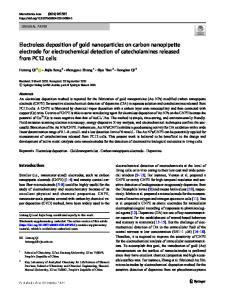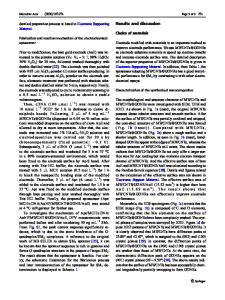Electrochemical Impedance Spectrocopy Study Of Glucose Adsorption On Gold Nanoparticles-Graphite Paste Electrode
- PDF / 396,006 Bytes
- 8 Pages / 432 x 648 pts Page_size
- 116 Downloads / 350 Views
Electrochemical Impedance Spectrocopy Study Of Glucose Adsorption On Gold Nanoparticles-Graphite Paste Electrode Azucena Osornio1, Luis A. García2, Leonor M. Blanco3, Rene Antaño1, Federico Castañeda1 1
Centro de Investigación y Desarrollo Tecnológico en electroquímica. Parque Tecnológico Querétaro s/n Sanfandila,
C.P. 76703, Pedro Escobedo, Querétaro, México. 2
Centro de investigación en Química Aplicada. Blvd. Enrique Reyna # 140 Col. San José de los Cerritos Saltillo,
Coahuila. México. C.P. 25294. 3
Universidad Autónoma de Nuevo León, Laboratorio de Electroquímica, Guerrero y progreso s/n, Col. Treviño,
Monterrey, N.L. C. P. 64570, Nuevo León, México.
ABSTRACT Electrochemical Impedance Spectroscopy (EIS), is a confirmed tool for investigation of electrode/electrolyte interfaces and surface-modified electrodes. In the present work, we apply this approaching way to obtain a deeper insight into the electrochemical oxidation mechanism of the glucose in alkaline media. We studied the EIS response of gold nanoparticles embedded in carbon paste and use it as an electrode for the electro-oxidation of glucose. The results were compared with those of a polycrystalline gold electrode. In order to determine the polarization potentials for EIS tests, cyclic voltammetry is first conducted in 0.3 M KOH with 10 mM glucose, recorded at a scan rate of 1 mVs-1. Three polarization potentials were chosen, corresponding to: the open circuit potential (OCP), glucose oxidation and gold oxide formation respectively. INTRODUCTION Gold is an attractive metal for oxidation of glucose, because its oxidation potential in neutral and alkaline medium is more negative compared with other metals. Nikolaeva et al (1), proposed a mechanism for glucose electro-oxidation at high potentials, in which a layer of gold oxide formed on the surface of the gold electrode may have a large catalytic effect on the oxidation of glucose (2, 3). Because the use of a massive gold electrode for the processes of oxidation is very expensive, in past decades, the gold nanoparticles (AuNPs), have been used as electrode, and even used as an imitation of various enzymes and are therefore also known as nanoenzimes (4). The oxidation of glucose on AuNPs, was first reported by Comotti in 2004 (4), the oxygen and glucose are consumed to produce gluconic acid and hydrogen peroxide, which are the same
2713 Downloaded from https://www.cambridge.org/core. Purdue University Libraries, on 04 Nov 2017 at 14:32:53, subject to the Cambridge Core terms of use, available at https://www.cambridge.org/core/terms. https://doi.org/10.1557/adv.2017.535
products generated by the glucose oxidase (GOx) (5). In this work we evaluate the oxidation of glucose using AuNPs supported in carbon paste electrode (AuNPs/C). The AuNPs/C electrode shows high sensitivity, good stability and reproducibility, making it a promising electrode for glucose enzyme-free oxidation. EXPERIMENTAL DETAILS Cyclic voltammetry were collected in a solution of KOH 0.3 M + 10 mM Glucose on both, gold polycristalin
Data Loading...











